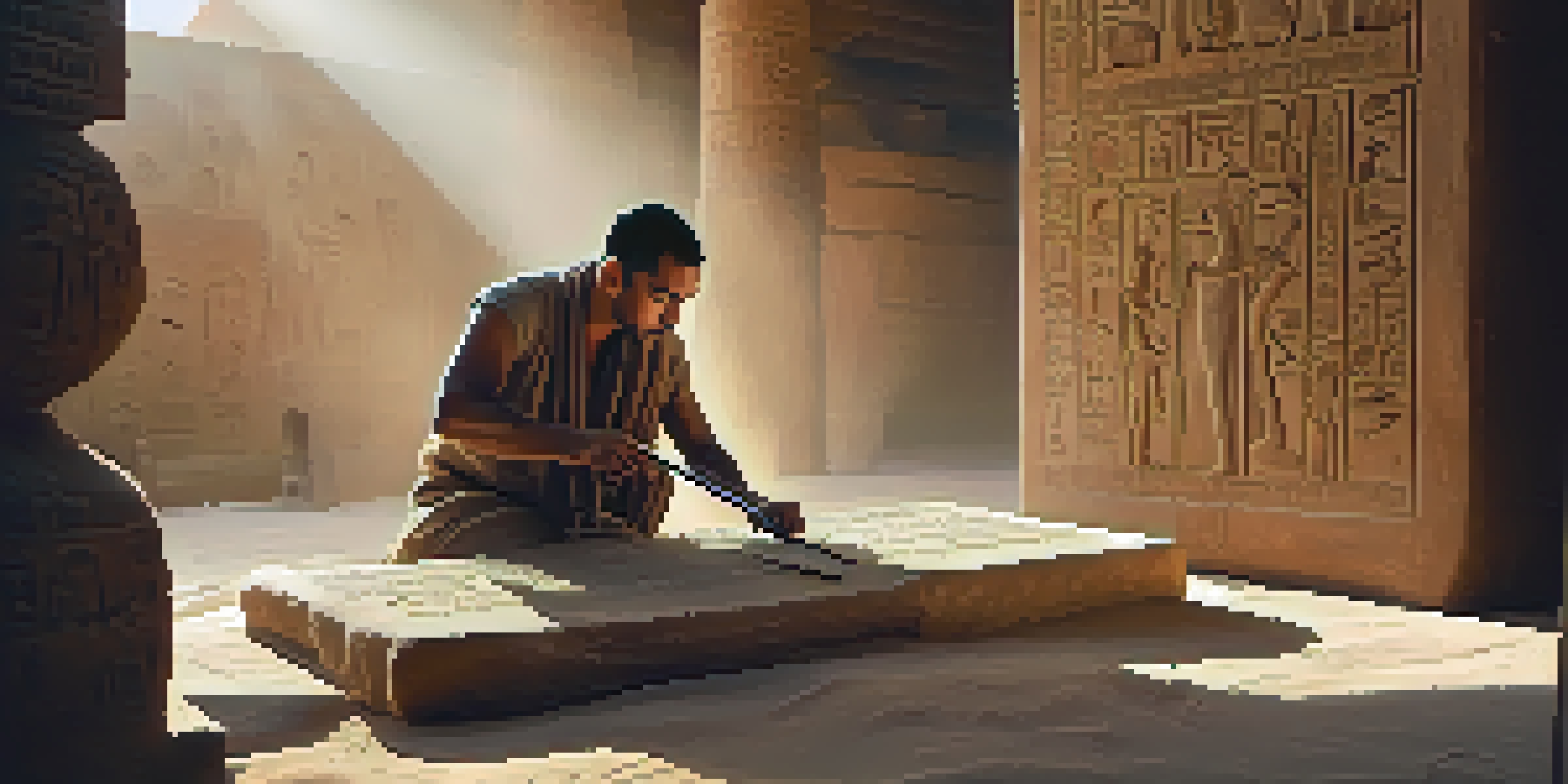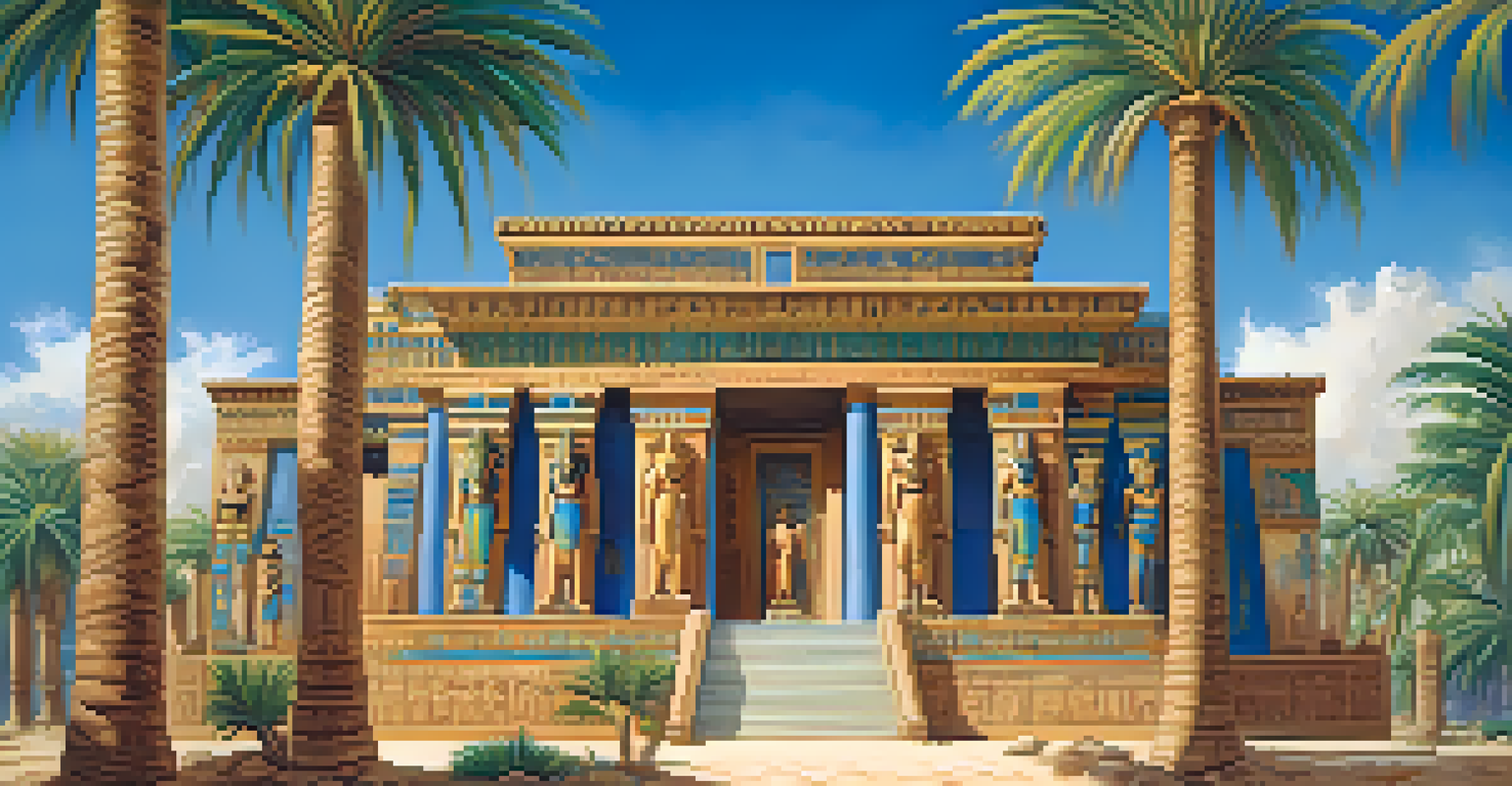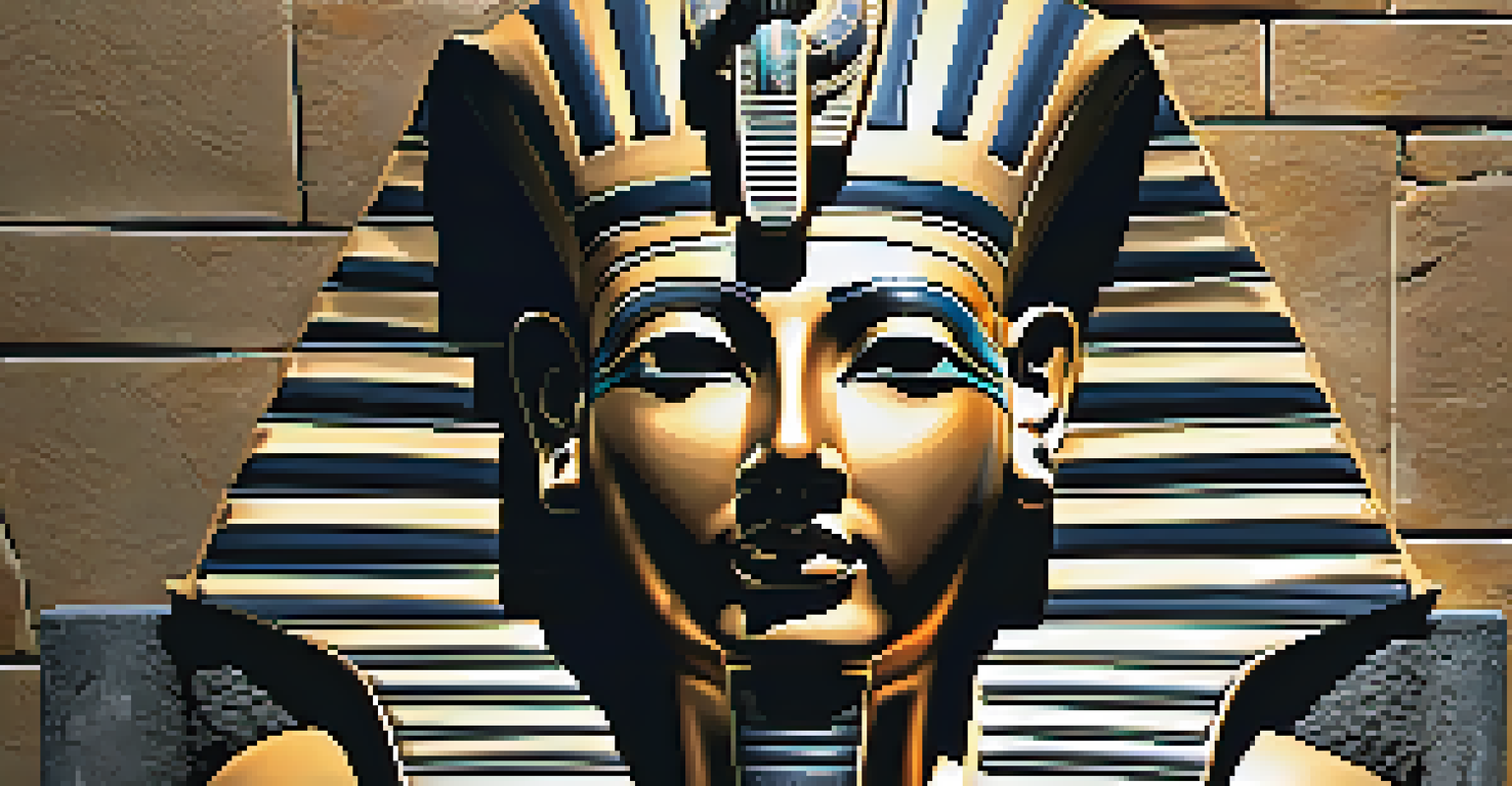The Evolution of Carving Techniques in Ancient Egypt

Understanding Ancient Egyptian Carving Techniques
Carving techniques in ancient Egypt were integral to their artistic expression, reflecting their culture and beliefs. The Egyptians utilized various tools and methods to create intricate designs on stone, wood, and other materials. These techniques played a crucial role in the construction of temples, tombs, and statues that still fascinate us today.
Art is the most beautiful of all lies.
The most common tools included chisels made from copper and later bronze, allowing for both fine details and broader strokes. The artisans would often use sand, water, and other materials as abrasives to achieve the desired finish. This combination of tools and techniques resulted in stunning carvings that depicted gods, pharaohs, and everyday life.
Moreover, the carving process was often a communal effort, with skilled craftsmen collaborating to produce large-scale works. Each artisan brought their expertise to the table, ensuring that the finished pieces met the high standards of ancient Egyptian art. This teamwork not only fostered a sense of community but also helped preserve their techniques for future generations.
The Role of Religion in Carving Artistry
Religion was a driving force behind many of the carving techniques used in ancient Egypt. The Egyptians believed that their carvings could serve as offerings to the gods and assist the deceased in the afterlife. As a result, many of the most famous carvings can be found in temples and tombs, showcasing their spiritual significance.

For example, intricate hieroglyphs were often carved into stone walls, depicting prayers and stories that were meant to guide the souls of the departed. The precision of these carvings reflected the beliefs that every detail mattered in the journey to the afterlife. This connection between art and spirituality elevated the status of carvers and their craftsmanship.
Ancient Egypt's Carving Techniques
The intricate carving techniques of ancient Egypt reflected their culture, utilizing tools and collaborative craftsmanship to create lasting artistic expressions.
Furthermore, the use of iconography in carvings helped convey complex religious narratives. Symbolic representations were carefully crafted to communicate ideas about life, death, and the divine. This meant that each carving was not just a decorative element but a vital part of the narrative structure of Egyptian spirituality.
Tools and Materials Used in Ancient Carving
The tools and materials used by ancient Egyptian carvers evolved over time, reflecting advancements in technology and artistry. Initially, they relied on simple stone tools to shape softer materials like wood and limestone. As the demand for more intricate designs grew, so did the sophistication of their tools.
The art of the sculptor is the art of making the invisible visible.
By the Middle Kingdom, copper and bronze tools became commonplace, allowing for greater precision and durability. These metals were used to create chisels, hammers, and other essential tools that transformed the way artisans worked. This evolution in tools enabled carvers to achieve finer details and more complex designs.
In addition to tools, the choice of materials played a significant role in the carving process. Harder stones like granite and diorite required more effort but resulted in lasting works of art. The decision to use specific materials was often influenced by their availability and the intended purpose of the carvings, showcasing the artisans' resourcefulness.
Styles of Carving: From Simple to Complex
Ancient Egyptian carving styles evolved from relatively simple designs to highly complex and detailed works. Early carvings often featured basic shapes and figures, focusing on functional representation rather than artistic flair. Over time, as techniques improved, artists began to explore more elaborate forms and details.
During the Old Kingdom, a distinctive style emerged characterized by stiff, formal poses and idealized proportions. This period set the groundwork for the artistic conventions that would dominate Egyptian art for centuries. The use of grid systems allowed artists to maintain consistency in proportions and achieve a sense of harmony in their work.
Religion Influenced Carvings
Religious beliefs motivated the creation of carvings that served as offerings and spiritual guides, showcasing the deep connection between artistry and spirituality.
As we move into later periods, such as the New Kingdom, the carvings became more dynamic and expressive. Artists experimented with perspective and movement, creating scenes that depicted action and emotion. This shift marked a significant change in the artistic landscape of ancient Egypt, reflecting broader cultural and social transformations.
The Influence of Geography on Carving Techniques
Geography played a pivotal role in shaping the carving techniques of ancient Egypt. The availability of specific stones in different regions dictated the types of carvings that could be produced. For instance, the quarries of Aswan provided high-quality granite, ideal for monumental sculptures and temple façades.
Additionally, the Nile River served as a crucial transportation route, allowing for the movement of materials and craftsmen. This accessibility facilitated the exchange of ideas and techniques among different regions of Egypt. As artisans traveled, they brought their unique styles and methods, enriching the overall artistry of Egyptian carving.
Moreover, the harsh desert environment influenced the preservation of many ancient carvings. The dry climate has helped protect stone carvings from weathering, allowing us to admire these works thousands of years later. This geographical advantage not only preserved their legacy but also allowed modern scholars to study and appreciate the intricacies of ancient Egyptian artistry.
The Legacy of Ancient Egyptian Carving Techniques
The legacy of ancient Egyptian carving techniques extends far beyond their time, influencing art across cultures and eras. The precision, symbolism, and craftsmanship seen in Egyptian carvings set a standard that many later civilizations aspired to achieve. Their techniques and styles can be seen echoed in Greek and Roman art, among others.
Moreover, the fascination with ancient Egypt during the Renaissance led to a revival of interest in their artistic methods. Artists sought to emulate the grandeur of Egyptian art, integrating elements into their own work. This cross-cultural exchange highlights the enduring impact of Egyptian carving techniques on global art history.
Legacy of Carving Techniques
The legacy of ancient Egyptian carving continues to inspire modern artists and influences global art, highlighting the timeless nature of their craftsmanship.
Today, we continue to study these ancient techniques, using modern technology to uncover their secrets. Digital imaging and restoration efforts allow us to appreciate the original beauty of these carvings. This ongoing exploration ensures that the artistry of ancient Egypt remains a source of inspiration for future generations.
Modern Interpretations of Ancient Techniques
In the modern era, artisans and artists are reinterpreting ancient Egyptian carving techniques, blending traditional methods with contemporary styles. This revival not only honors the past but also breathes new life into the artistry that once flourished in ancient Egypt. Many contemporary artists are incorporating motifs, symbols, and techniques inspired by ancient carvings into their work.
Workshops and courses teaching ancient techniques have emerged, allowing a new generation to connect with this rich heritage. These programs emphasize the importance of craftsmanship and the patience required to master carving. Participants often find joy in the tactile experience of working with stone, echoing the practices of their ancient predecessors.

Furthermore, modern technology, such as CNC machines and 3D printing, is expanding the possibilities of carving. While these tools offer efficiency, many artists still prioritize hand-carving to maintain the authenticity of their work. This fusion of old and new highlights the enduring relevance of ancient Egyptian carving techniques in today's artistic landscape.